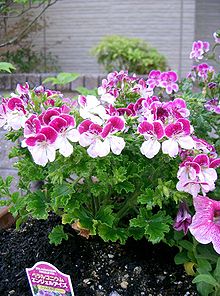Fragrant pelargonium
The fragrant pelargoniums include a whole range of species and varieties from the genus pelargonium , all of which are characterized by the fact that they emit an intense scent of mint , roses , lemons or spices (sometimes only after carefully rubbing the leaves) .
Types (selection)
- Pelargonium citrodorum , which smells of orange
- Pelargonium crispum , which smells of lemon
- Pelargonium citrosum , which smells of lemon
- Pelargonium filicifolium , whose scent is reminiscent of rue
- Pelargonium fragans , whose scent is reminiscent of pine
- Pelargonium graveolens with its rose-like scent
- Pelargonium odoratissimum with a scent of apple and lemon
- Pelargonium quercifolia , smells of pine needles
- Pelargonium tomentosum , which is also called the peppermint pelargonium because of its fragrance .
- Pelargonium cucullatum , which gives off an incense-like, spicy scent
- Pelargonium capitatum , the scent of which is reminiscent of roses
Use in the kitchen
(Pelargonium odoratissimum) is also called apple-scented pelargonium because of the predominant apple scent of the leaves , has round, toothed leaves and small white or white / pink-colored flowers on small tendrils. In contrast, the popularly known lemon geranium (Pelargonium citrosum) has a forked, branched leaf shape, but similar flowers.
The leaves of the apple-scented pelargonium are used because of their apple-cider-like aroma for perfumes and as a spice , especially for desserts, and according to DIRECTIVE 2001/113 / EC OF THE COUNCIL of December 20, 2001 on jams, jellies, marmalades and chestnut cream, they are allowed for human consumption of the EU of jam , extra jam, jelly , or extra jelly made from quince .
literature
- Wiegele, Miriam: Scented pelargoniums. Cultivation, care, varieties . Ulmer (2000). ISBN 38001-3133-1 .
- Wiegele, Miriam: Select and enjoy fragrant pelargoniums . Av Book (2010). ISBN 37040-2380-9 .
- Tolley, Emelie: herbs . DuMont (1987). ISBN 3-7701-2100-7 .
Web links
Individual evidence
- ↑ Scented pelargoniums , accessed May 27, 2018
- ↑ Directive 2001/113 / EC (PDF) of the Council of December 20, 2001 on jams, jellies, marmalades and chestnut cream for human consumption

